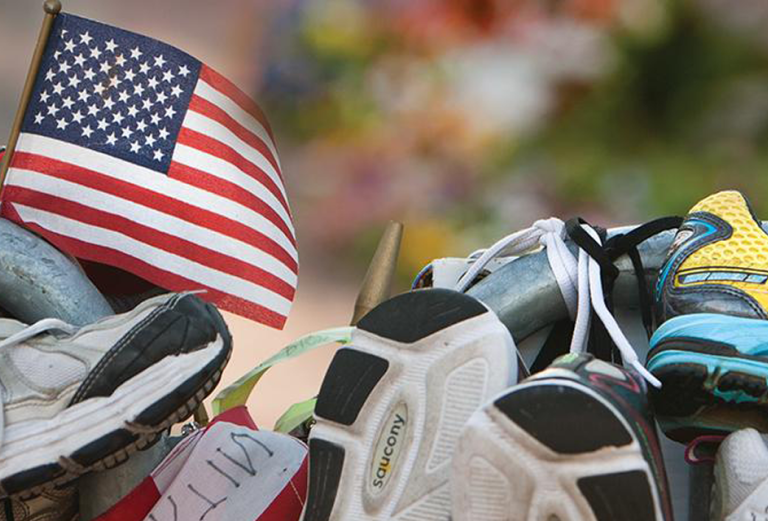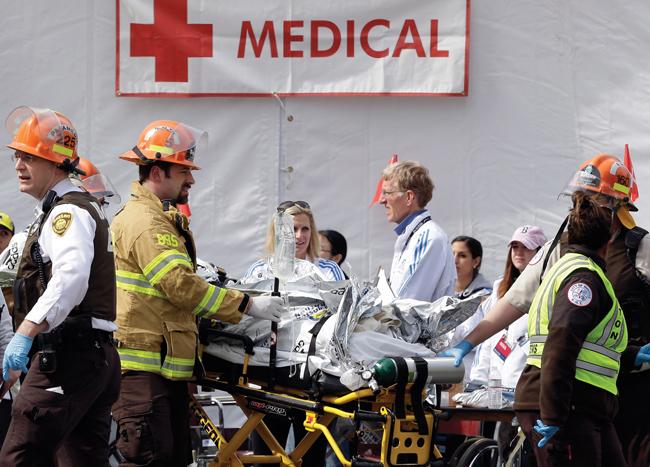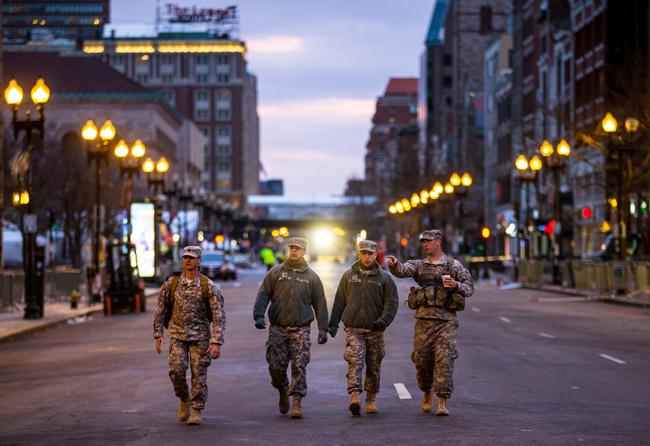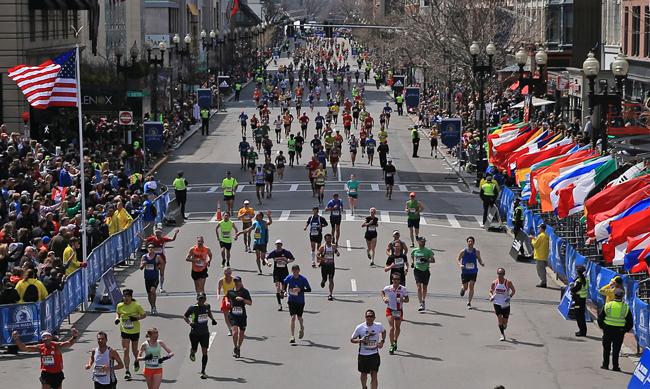Sequelae
A community reflects on a day of tragedy
- 16 minute read
- Feature

Boots paced Boylston Street just hours after running shoes had slapped its surface on Patriots’ Day 2013. The joy of the annual Boston Marathon had been violently displaced by feelings of disbelief and confusion that were shared by residents and visitors. On the HMS campus, however, those feelings were quickly submerged, replaced by a need to help, a drive to serve, and a compulsion to undo the damage done to those who had been maimed, injured, traumatized. HMS students and alumni recall the experiences of that day.
The Expectation
Anne Stack ’88 turned to Twitter to confirm the news. “It was so out of context that I wondered if it could be real.” Then she logged on to CNN. “Feed after feed was saying, ‘Explosions at the finish line. Major injuries.’ That was enough confirmation for me to know something bad had happened.”
On April 15, Stack, anticipating traffic from marathon spectators, had arrived at work early and reported to the emergency department. It was 2:58 p.m., and the department’s radio, the one linked to the Boston EMS, was reporting a crisis. “We initiated Code Triage, the hospital’s disaster plan,” says Stack, an HMS associate professor of pediatrics and clinical chief of the Division of Emergency Medicine at Boston Children’s Hospital, “and we began to prepare for a potential mass casualty event.”
Notified that they were about to receive “three criticals,” Stack, who had been designated as trauma team leader, began to organize three trauma teams. At 3:15 p.m., the first patient, a seven-year-old girl, arrived. “I remember the medics’ faces; they looked shaken,” says Stack. “The first thing one said was, ‘Tourniquet time, 1500 hours.’ I didn’t know what he was talking about. ‘Tourniquet?’ He didn’t reply, just moved his eyes to where her left leg was. I picked up the sheet and knew then what he was talking about.”
Stack’s team swarmed around the girl, checking her airway and circulation, looking for injuries, providing her antibiotics, dressing her wounds. “She smelled like burned hair and soot and explosion,” says Stack. “She was understandably dazed. We were asking her questions, but she couldn’t hear well. The explosion had ruptured her eardrums.” Then, in keeping with procedure, the team rolled the girl over to check her back.
“There were multiple shrapnel wounds,” says Stack, “and there were nails and BBs. As I began to remove some of the superficially embedded material, I felt a moment of disgust. I could not believe someone would do this to inflict even more injury. That shook me for a moment, but I realized I needed to refocus to care for her.”
Stack had worked in Haiti after the earthquake in 2010 and recalls that the emotional consequences of that deployment had surfaced a couple of weeks after she returned. Stack expected the same emotional response to the bombings, but it never came. “Here, the system worked beautifully,” she explains. “I was proud of our team, proud of the hospital’s response. Everyone rose to the top of their game; there was this feeling of overwhelming thankfulness.”
The Response
“It wasn’t silent,” says Arun Ramappa ’96. “There were a lot of different voices. There were a lot of players in this cast.”
That cast included emergency medical technicians, physicians, residents, nurses, and a host of other caregivers who were either at Beth Israel Deaconess Medical Center or near enough to return when word of the blast began percolating through the hospital community.

Ramappa, an HMS assistant professor of orthopedic surgery and chief of sports medicine and shoulder surgery at the hospital, had been in his office completing some paperwork when his fiancée called him. She had tried repeatedly to reach him, Ramappa says, but “for some reason the phone wasn’t working.” Then a colleague who was on call for orthopedic trauma told him there had been a blast. “She headed for the emergency department, and I quickly followed,” he says.
At the emergency department, Ramappa was tasked to triage patients to determine which victims needed to be sent to the operating room and in what order. He estimates that he assessed a number of patients that totaled “in the teens,” and assisted in about seven surgeries.
“Patients were lined up side by side, so you’d have one set of caregivers assisting one patient and another set caring for the next, and the next, and the next. There were a lot of separate conversations going on.” Despite the rapid influx of a large number of patients, says Ramappa, “we were able to handle things well. It was quite amazing, the response.”
It’s that response that has stayed with Ramappa. “That day showed how this community could come together. As we were working and working with patients, people showed up, all these caregivers eager and waiting to help.”
“Being able to help that day was gratifying and affirmed for me why I became a doctor,” Ramappa adds. “For me, the lasting image of that day is all those people. There. Ready.”
The Purpose
The text message on Brian Grottkau’s mobile phone read, “We’re okay, don’t worry.” It was from his wife, who Grottkau knew was at the marathon, cheering on her brother.
Grottkau ’89 tapped a reply, “What are you talking about?” Her response prompted him to wrap up the preoperative discussion he was having with a patient and to head for the operating rooms where Grottkau, an HMS assistant professor of orthopedic surgery and chief of the pediatric orthopedic service at the Mass General Hospital for Children, was about to become, as he puts it, “a minor bit player in a real big production.”
Together with R. Malcolm Smith, chief of the orthopedic trauma service at Massachusetts General Hospital, and a troop of residents, Grottkau began checking the operating rooms, dropping off residents as necessary to augment teams working with victims who were dazedly answering questions from doctors and police. At the final room, Grottkau became the attending on a traumatic amputation. Later, he triaged newly arrived victims.
But it wasn’t until he arrived home that Grottkau felt the full weight of the day. “I was watching the bombing on the news and heard the disbelief in the voices of my wife and kids.”
“I went to the Watertown Police Department a couple of days later and asked one officer, a friend, how he was doing. ‘Were you involved in the shootout?’ He told me he had been. ‘Thank you,’ I said. ‘Did you care for some of the victims?’ he asked me. I told him, ‘I did a little.’ ‘No,’ he said, ‘thank you.’ ”
Reflecting on that conversation, Grottkau says, “You do your job and you do what you think is right. I just did my job. The reason I became a doctor was to help people.”
The Bond
It was the first day of their family vacation. Edward Kenneth Rodriguez ’97, his wife, and their three children had traveled to Southern California, where Rodriguez had attended graduate school. He planned to show them the highlights of the area, beginning with a meal at a favorite restaurant. He was about to tuck into a burrito when his wife, who was seated facing a television screen, put down her food. “She said, ‘Oh my God! Look!’ ” Rodriguez recalls.
Rodriguez turned and saw the news flashes of the bombing in Boston. “My cell phone began to ring,” he says. As an HMS assistant professor of orthopedic surgery and chief of orthopedics trauma surgery at Beth Israel Deaconess, Rodriguez is high on the emergency call phone tree. He started making calls to his team and learned there was a sufficient number of surgeons responding to the crisis. But his other questions would go unanswered; his phone calls would no longer go through.
Rodriguez took the next flight to Boston, a red-eye that landed around 5:00 a.m. “I went straight to work,” he says.
On that morning after the bombing, Rodriguez began to handle the second round of debridements for some of the victims. Trauma care for amputations involves the immediate removal of debris and dead and damaged tissue, a wait of 24 hours, then successive surgical debridements until the wound is considered safe from infection, and safe to close. It’s a procedure that has been honed on the battlefield. “Unfortunately,” says Rodriguez, “in the past ten years or so, we’ve had a tremendous amount of information coming into the medical community via the military on how to handle blast injuries.”
Rodriguez is no stranger to trauma injuries, having gone through fellowship training at the R. Adams Cowley Shock Trauma Center at the University of Maryland Medical Center. During his year there, which occurred early in the Iraq conflict, he helped care for overflow patients transferred from Walter Reed Army Hospital. And while he has worked with similarly injured victims of accidents or workplace explosions, “This was a group of young patients. And truly innocent,” says Rodriguez. “These people had done nothing to bring this upon themselves. They had just planned to enjoy a beautiful day in Boston. I know we provided good care, and I’m proud of how well we worked together to help the patients. But I also think of how the world has changed for them.”
The Future
The Patriots’ Day holiday meant that many students tossed out their usual routines in order to get in some marathon watching, some gathering with friends, some extra study, or some welcome shuteye. This free-form scheduling presented a challenge to those responsible for accounting for the whereabouts of all University students following the bombings. For Nicholas Christakis ’88, who is now the Sol Goldman Family Professor of Social and Natural Science at Yale University, and was then an HMS professor of medicine and co-Master of Harvard College’s Pforzheimer House, that accounting meant gathering information on the nearly 400 students who live in the undergraduate residence. For David Roberts ’95, an HMS associate professor of medicine and the director of the principal clinical experience at Beth Israel Deaconess, it meant handling a deluge of text messages from students eager, but uncertain whether, to help.

Two of those HMS students were Eduardo Hariton ’14 and Nina Gold ’14. April 15 found them on the cusp of their fourth year—and of an experience that would confirm for them the wisdom of their career choices.
Hariton was at home when news of the bombings came. “I paged my chief resident from the trauma service and said, ‘If you need an extra body, I’m happy to come in.’ ” The uncharacteristic reply came within minutes, “This one time you should come in.” Hariton tossed on some scrubs and ran the few blocks to Beth Israel Deaconess.
As he ran, Hariton had disjointed thoughts of lessons learned in Israel during his work as a first responder for that nation’s emergency medical service, Magen David Adom: apply tourniquets on severed limbs to control bleeding; shrapnel will increase the number of injured; if the bomb was big, victims will have significant burns.
At the emergency department, he was directed to find a room with a patient and to stay with that patient; he was to provide continuity as caregivers came and went. Hariton stayed with two victims; each had fractures and wounds embedded with shrapnel.
By early evening, things had quieted. “The adrenaline stopped pumping, and I started reflecting,” says Hariton. “I had a sense of fulfillment. I hadn’t taken care of severely injured people, but I had watched the people I had trained under for the past three months do so and knew that one day I would be able to give that sort of care. I was proud to be part of that team.”
Gold’s role in caring for the injured came in the days following the bombings. As a medical student with the consult liaison psychiatry team at Beth Israel Deaconess, Gold was a part of the team’s efforts to help victims cope with the trauma they had experienced.
Relaxation exercises were key to that end. Getting victims to relax to the point where they choose to speak about their experiences, rather than being pressured to talk about them, has been shown to be helpful for victims and their families. Gold recalls seeing how effective this approach can be. “I watched a senior psychiatrist work with a patient. He began by simply asking the patient to relax every muscle in his body, from his face down to his toes. As he did this, I saw peace come over the man’s face.” Learning to self-soothe, says Gold, can be especially vital to those with amputations who begin to experience neuropathic pain.
Working with the team, Gold was “uplifted by the resilience I saw in the patients. Yet I still feel horrified by this act of violence. I’m upset that the city I grew up in was victimized.”
But as far as her chosen field, Gold is more certain than ever it’s right for her. “I am proud to be a part of the medical community. It’s the only thing I can imagine myself doing.”
The Insight
Joaquim Havens ’04 was deep into a discussion of data with a hospital resident when he heard a knock on his office door. “It was a frantic knock,” says Havens, “and when we answered, the request was urgent. ‘They need you in the emergency department right now.’ ” So Havens, an HMS instructor in surgery at Brigham and Women’s Hospital, headed for the emergency department. There, he pushed open the double doors and looked upon a scene of “controlled chaos.” He approached the first senior staff person he saw: “What can I do to help?”
Asked to evaluate the patients, Havens began going room to room, checking each patient’s breathing and blood pressure and ensuring there were resources available for the patient’s needs. When it was determined that sufficient resources had been deployed and the situation was under control, Havens and others began to prepare for the next wave of patients.
“Ultimately, we treated 39 casualties,” says Havens. “Twenty-three arrived in the first hour.” The patients ranged in age from 19 to 65.
Eleven patients underwent surgery that first night; Havens performed one of the surgeries, handling a penetrating wound to the neck.
As associate director of the hospital’s surgical residency program, Havens was pleased at the residents’ response to the crisis. “We had nearly every surgical resident in training there and helping,” he says. As valuable as that experience was to the residents, it has led to some emotional ups and downs. “We’ve done some deep reflective briefings on coping with this experience, both emotionally and medically,” adds Havens. The talking also helped him. “I opened up about myself, too, and shared my fears and feelings and emotions. I’m an attending, but I wanted them to realize that this sort of experience affects me as well.”
Those conversations, and a weekend with his wife in Maine, have helped Havens get back to normal. For him, that has meant “not watching the news and not thinking about that day each waking moment. It has meant trying to feel like the world hasn’t completely changed.”
“Being a doctor is a lot more than amassing a volume of technical knowledge,” Haven adds. “It’s interacting with patients, their families, your colleagues, and the people you’re training. You can’t separate yourself from this work. You take a little piece of it home with you every day.”
The Unexpected
Glenn LaMuraglia ’79 walked along Boylston Street the day before the marathon. He lives blocks from the finish line, so this was a neighborhood amble. “It was a sunny day,” says LaMuraglia, “and there were all these happy people walking along, speaking so many different languages, and wearing the blue and yellow shirts of the Boston Athletic Association. I remember thinking, ‘Wouldn’t it be nice next year to maybe work out and run the marathon?’ ”

That warm mood dissolved the next day when LaMuraglia, an HMS associate professor of surgery at Mass General, was closing after surgery on an aneurysm. A nurse had entered the operating room to ask the scrub nurse to stay around. “We asked, ‘What’s going on?’ ” says LaMuraglia. He and his colleagues then learned of the bombings.
The surgical team finished its work, and LaMuraglia set out for the hospital’s emergency department. “When I arrived, it was obvious the place had been filled with people who had been bleeding,” he says. “There were sheets and dressing wrappers and other stuff all around. And there was blood on the floors of various cubicles.” As LaMuraglia walked by one room, he saw a patient inside. He asked the physician in the room, George Velmahos, the HMS John Francis Burke Professor of Surgery at Mass General, if he could help.
“ ‘Well, Glenn,’ he said, ‘I’m glad you came by. We’ve had a series of patients come in with their legs blown off. But this is one we may be able to save.’ ”
LaMuraglia joined the effort. The team fixed the fracture using an external structure of pins and wires, and LaMuraglia worked to re-establish a blood supply to the limb. “Everyone rose to the occasion,” he says, “the nurses, the techs, the operating room staff all were phenomenal. Things appeared as if by magic.”
“We all were so focused,” adds LaMuraglia, “just concentrating on the work. We ended up taking a two- or three-inch piece of metal out of the patient’s leg; I think it was a piece of a pressure cooker.”
The structure securing the fractured bones needed to be readjusted under x-ray, so, before LaMuraglia could continue, he had to step out of the operating room.
In that moment of stillness, something happened to LaMuraglia, something “that’s never happened to me in all my years as a surgeon.” His eyes welled up. “For all the surgeries I’ve done and the patients I’ve cared for, this one tasted different. This one had a flavor that was tragic.”
The operation continued, and LaMuraglia performed a venous bypass linking the blood supply from behind the knee to the ankle. To the joy of the team, the foot began to pink. That elation, however, was shattered a couple of days later. The damage to the limb had been so extensive that the orthopedic team determined it was better to remove it.
A week or two later, after Boylston Street had been reopened to pedestrians, LaMuraglia again took a morning walk. Visiting the makeshift memorial that had become a site of public grief and condolence, LaMuraglia noticed that one of the barriers that formed the memorial’s backbone had toppled over. So, together with a kid who was standing nearby, LaMuraglia righted the structure. “We were able to get it back to normal,” he says.
Ann Marie Menting is editor of Harvard Medicine magazine.